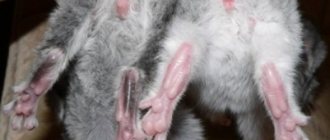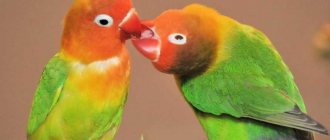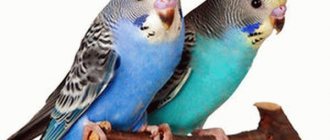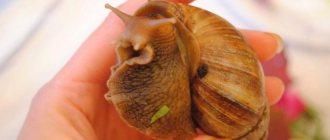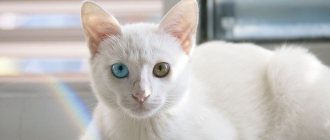Lovebirds are the most popular bird species to keep at home. They are distinguished by their small size, beautiful color and cute behavior. When choosing a parrot, it is important to pay attention to both the sex and age of the individual, because the bird’s further behavior, its ability to reproduce and the length of its life in the family depend on this. But how to distinguish lovebirds when buying? Let's look at the secrets of determining the age and sex of birds in this article.
How to find out age
Not only an experienced breeder can determine how old a bird of paradise is. There are several simple principles on how to find out the age of a bird. When purchasing, it is important to pay attention to the appearance of the parrot: this will allow you to choose a young individual. Sellers in pet stores most often know the exact date of chicks' departure from the nest: this is enough to determine the days of life of individuals. If it is impossible to find out this moment, you can determine how old the parrot is yourself during the examination of the pet.
According to the shape and size of the head
Lovebirds grow quickly. Within a month they reach the size of adults. It is for this reason that determining the age of a bird by the shape of its head is an impossible task. This characteristic can help determine gender: girls have larger heads than boys.
By the eyes
Eye examination is one of the most popular ways to determine the age of a lovebird. Young individuals have a peculiar eye structure. In the first weeks of life, lovebirds have enlarged pupils: they almost completely cover the whites. They appear to have black eyes. The pupils become smaller over time. If in front of you is a parrot with normal-sized pupils, it is already an adult.
By the beak
Young parrots have a small and thin beak, while in adults it is massive and strong, often curved. Young parrots have darker skin over their beaks. This area is called the "cere". After a few months, it brightens, merging with the overall color. Often young lovebirds have tissue separation on their beaks. This is caused by the growth of new tissue over the beak of babies. During this period, birds need proper and regular nutrition, as well as attention from their owners. In 99% of cases, tissue renewal occurs without complications.
By paws and claws
A convenient and simple method to determine the age of a lovebird is to examine the bird’s legs. In chicks, the skin over the claws is soft and light. With age, it darkens due to the development of scales. Birds' claws grow gradually, but it is difficult to determine their age, because after a month they reach a standard size.
By appearance
Birds, like people, change every year. When choosing a pet, you should pay attention to its plumage, color, pupil size, head and paws. This will allow you to choose a pet of the age you need. Remember that young birds have brighter colors and are more active.
By color
Young lovebirds have brighter and shinier feathers. They have a hint of gray on their wings and neck. The overflow effect disappears already at six months of age. In adult parrots, the color is uniform and more matte. Lovebirds, when reaching adulthood, become almost completely green. A yellow or red tint in parrots after a year is noticeable on the throat, neck, head and back. The color differs not only in young and adult individuals, but also in males and females.
Lovebird parrot cost
As a rule, Fischer's lovebirds are kept as pets, although masked and red-cheeked lovebirds are no less popular. Their estimated cost does not exceed 2 and a half thousand rubles. According to some observations, red-cheeked lovebirds are the cheapest among them, but Fischer's lovebirds and masked lovebirds can cost a little more.
How to find out gender
Experienced breeders can determine the sex of a bird at first glance. There are 6 ways to distinguish a boy from a girl lovebird.
According to the shape of the head
Male parrots have smaller heads than females. Males have a lower forehead and an angular nape, as well as a flatter head. Many people call this shape “cut”. Females, in turn, have a voluminous but short head.
By the beak
How to distinguish a female from a male? Examine the parrot's beak. In girls it is thin and small, boys have a thick and wide beak. Sometimes males are distinguished by their colored beaks: a combination of yellow and orange colors. Females have monochromatic beaks: yellow, white or brown.
Along the pelvic bones
You can find out the sex of a chick by the size of its pelvic bone. This procedure must be carried out very carefully, since parrots have fragile bones. Inspection can be difficult due to the bird's aggressive reaction to touch. Males and females may spit or scream when their territory is invaded.
How to palpate the pelvic bones? It is necessary to place the bird on your hand with its belly up. It is necessary to palpate the pelvic bones gently. Place your fingers on the bird's body, feeling for any protruding bones. It is necessary to determine the distance between them. In boys, the gap between the pelvic bones will be less than a centimeter, and in girls - 1-2 cm.
It is also worth paying attention to the width of the pelvic bones. Females have a wider pelvis because they lay eggs. During laying, the distance between the pelvic bones of females increases to ensure free release of eggs.
To size
The size of the bird depends on the sex of the individual. Lovebirds can be distinguished within a couple of weeks after birth. Females have a small body, but this cannot be seen with the naked eye. Boys and girls of the same age are practically the same in size.
By color
Experts use another way to distinguish between male and female lovebirds: inspection of the feathers. The color of a bird's feather indicates not only its age, but also its gender.
Lovebird boys have bright and rich colors. They are distinguished by shiny green, yellow or red feathers. Females have lighter plumage. The pattern is also different: for girls it is chaotic. This difference is explained by the fact that males use bright colors to attract the attention of females.
By behavior
The behavior of males and females has a lot of differences. Lovebird girls pay more attention to their appearance: they often wash their feathers and look in the mirror (if there is one in the cage). They also love to scold their partners. If there are 2 parrots in front of you, one of which is constantly pecking or grumbling at the other, know that the female is screaming.
Girls of this species are more thrifty: they bring materials for building a nest, they can hide food and other things that they think are important. There is an interesting test for checking the sex of a bird: put a napkin next to the cage - the girl will definitely crush it to build a nest.
Vivid differences between individuals of both sexes appear during the mating period. Boys at this time behave radically differently than in everyday life. They rub against the perches, pester the female, and may scream.
When do sexual characteristics appear?
Buying a lovebird is a responsible and slightly risky undertaking. The difficulty is that instead of a boy or girl, you can buy a bird of the opposite sex. This is fraught with consequences, especially if there is already one parrot at home. It is easier to determine the female or male of lovebirds when they are older, when visible differences begin to appear. Another nuance is their behavior: the boy behaves calmly, but the girl is afraid of people and often “preens.”
Attention! It is better to buy lovebirds as adults, so as not to miscalculate the gender.
The easiest way is to find an already formed pair living in a cage together. True, in this case the seller may not say anything about their age. The bottom line is that in order to purchase a lovebird of the desired sex, you should always carefully examine its appearance.
Behavior
For those who do not know how to determine the sex of a lovebird parrot, you should carefully monitor its behavior. The actions will be different for different genders. Of course, not all people will be able to see the differences. It is better to have someone to compare with, and therefore you should look at several birds at once.
Experienced breeders believe that females spend more attention on themselves and their appearance. They will constantly lead like humans. Birds preen their feathers, preen themselves, and are generally more active individuals. This behavior is very noticeable if there is a male next to the female. In addition, only female birds can find branches or pieces of paper and stick them between their feathers. In parrots, females think that this way they can interest the male more. Therefore, if the buyer sees an active animal that is concerned about its beauty, then it is definitely a female.
The last unusual method that allows you to distinguish between sexes is to turn the individual over. In other words, to determine the sex, a person needs to take the bird by the legs and turn it over so that the bird is pointing head down. It is believed that a male parrot can remain suspended for a long time and remain very calm. While the female representatives will get scared and begin to bend their paws and press closer to the palm. But it is not recommended to use this method. No matter what, this is stress for the birds.
Birds from the same brood or family
A pair of birds must be purchased from different nurseries or from different breeders. Parrots that are close in blood cannot become parents of full-fledged offspring. This can lead to various complications:
- empty, unfertilized eggs;
- small masonry;
- poor survival of offspring;
- external defects in chicks.
On a note. Close relationships are used for breeding birds and obtaining new shades of plumage. This method is not suitable for crossing lovebirds at home.
Diet
When preparing birds for mating, their diet is saturated with protein foods: cottage cheese, eggs, insects. It is good to feed your pets cereals: rice, oatmeal, pea. You can add sprouted seeds, honey (2 g), lemon juice (no more than 2 drops per day).
In summer, the birds’ diet does not change; they have plenty of natural vitamins from seasonal vegetables and fruits. In winter, special complex supplements are introduced for parrots. Pet food is enriched with phosphorus and calcium. These elements are found in abundance in bone meal, eggshells, and nuts.
Head shape
Many researchers note that if you look at parrots in profile, the female’s head will be more rounded and compact , while the male’s will have a low forehead, an angular back of the head, and a flat head on top. If you look from the front, the beak of females is also round and pale. Males have a brightly colored beak; you can notice a sharper rib in the middle of the beak. But based on these visual signs, unfortunately, it is impossible to accurately determine the sex of a lovebird, especially if it is alone and not in a crowd of relatives. The shapes often depend on the age and constitution of each particular parrot.
Problems associated with raising chicks
A novice parrot breeder can understand how lovebirds are bred at home. Despite the simplicity of the process, you may encounter unforeseen circumstances.
- Non-viable chicks. This happens due to poor nutrition and the health of their parents. It is also necessary to check the humidity and temperature in the house.
- Why does the female refuse to take care of the babies? Perhaps she is less than 12 months old and her maternal instinct has not formed. The next time she can be allowed to mate only after a year.
- Lovebirds can kill their offspring. This is due to lack of food or abnormalities in the development of the parent. Such individuals are no longer allowed to reproduce.
- The female pecks the eggs or pulls out the feathers of the babies. Evidence of calcium deficiency or disturbances in the process of its absorption. The bird's diet is enriched with the necessary element. If this does not help, the brood is removed and raised on its own.
Basic recommendations on how to breed the inhabitants of Madagascar have been received. All that's left to do is create a beautiful family of lovebirds and wait for the chicks. In conditions that are as close to natural as possible, birds give birth to strong, healthy offspring with bright plumage.
